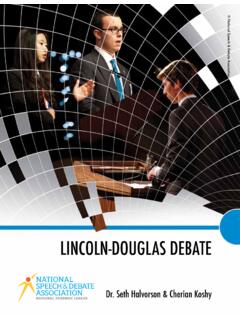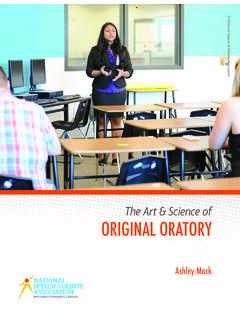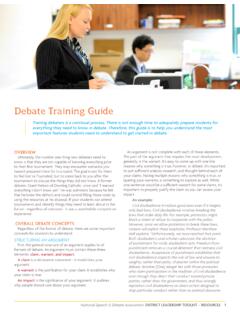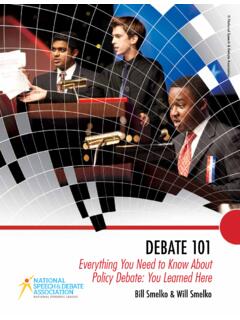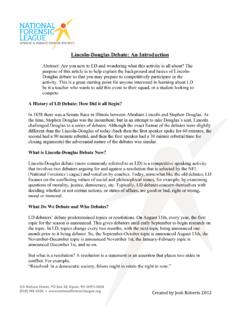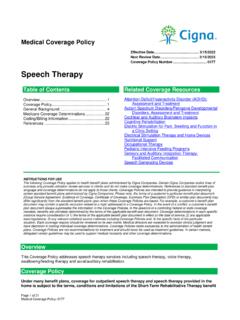Transcription of Speech and Debate Glossary
1 National Speech & Debate Association: Speech and Debate Glossary 1baSIc toUrnaMent terMInoloGy ballot: the sheet of paper or online location where judges write the results of an individual round of competition, which they submit to the Tab Room or online tabulation system. break: (v.) advancing to the next level of competition; (n.) break rounds also called elimination (elims) or out rounds are much like playoffs, with certain numbers of students eliminated at the end of each heat. The last break round of a tournament is the final round, or finals, featuring two opposing Debate teams or six Speech contestants. Also see posting. code: many tournaments use a code system to keep the identity of contestants and their schools anonymous.
2 Codes are often a combination of numbers and letters, which designate school, event, and sequence (how many students from a particular school are in a given event). divisions: categorizations of competition at a tournament, such as varsity, junior or JV, novice, and open. Flight: due to room or time constraints, tournaments will sometimes schedule back-to-back contests in the same room during a single round s timeframe. Forensics: overarching term for Speech and Debate , though it sometimes connotes Speech competition, particularly in states with split Debate and Speech seasons. Judge (or adjudicator): an adult who evaluates a round of competition. Judges are drawn from educators, former competitors, and business professionals.
3 Judges drawn from members of the local community, including parents are considered lay judges, for their lack of technical understanding of competition standards. Judges should be equipped with a timing device, writing utensils, and paper. prelims: guaranteed preliminary rounds at a tournament, before competition breaks to elimination rounds. posting: (v.) process or (n.) location of prelim schematics or list of contestants breaking to elims. record: in Debate , the win-loss ratio, or in Speech , the total ranks; a general standing of success. round: an individual heat of competition, where students are matched to (an) opposing contestant(s) in a particular room with a particular judge or panel of judges.
4 Rounds are sometimes divided into flights. Schematics (or schem, schemats ): matrix that assigns students to compete in particular rooms with particular judges for each round. In Debate , these are often called pairings. These can be physically hung at tournaments or released online. tab room (or Tab): short for tabulation, this is the tournament headquarters, where results are computed. To protect the integrity of competition, there are usually protocols about seeking permission to enter the tab : (or tabroom): An online tournament software hosts can use for registration, creating rounds, and results calculation. Speech and Debate Glossaryas with any specialized activity, jargon and abbreviations pervade Speech and Debate activities.
5 This guide covers some of the most essential terms of art that will alleviate your uncertainty as a new coach, as well as the hesitancy any students new to Speech and Debate may feel. National Speech & Debate Association: Speech and Debate Glossary 2 Speech anD Debate GloSSarydebate terMInoloGy affirmative/pro: the team or competitor who argues in favor of adopting the resolution. burden of proof: the affirmative s responsibility to prove that the resolution is true. If the affirmative fails to prove the resolution, they ought to lose the Debate . burden of rejoinder: the negative s responsibility to disprove the affirmative case. If the negative fails to disprove the resolution, they ought to lose the Debate .
6 Clash: Direct responses to an opponent s arguments. Also see refutation. constructive: the first Speech given by each debater (both teams) in a round, used to build a case. New arguments are permitted during constructive speeches, which distinguish them from rebuttals (wherein new arguments are not allowed). contention: claims made for or against the resolution, often stated in one declarative sentence. A Debate case may be organized into benefit analysis: one of the most common ways to decide a Debate round, this philosophy requires a judge to analyze the benefits of a policy versus the cost. In other words, does the proposal do more harm or good? counterplan: the negative admits the present system should be changed, but argues that the negative team s proposal (plan) is better than what the affirmative has offered.
7 Criterion: standard, rule, or test on which a decision or judgment is based. In policy Debate , the basis for establishing or evaluating policy ( , net benefits). In value Debate , the criterion is the method by which the value is assessed ( , the value of safety can be measured in terms of freedom from harm; , a person is safe when they are not being harmed, and that s how you know that safety is occurring). cross-examination (or Cross-Ex, CX ): period of time when debaters ask each other questions. Flowing: note-taking during a Debate , accurately recording the most important arguments and rebuttals. The paper on which this note taking occurs is known as a flow. Inherency: the reason a problem still exists.
8 Also understood as the barrier to solvency. For example, if the federal government passed a discriminatory law, then that law would be the inherent barrier to a just society. Judging paradigm/preferences: a judge s educational philosophy; the model or view that guides his or her decision. In other words, what a judge does or does not want to hear in a round. negative/con: the team or competitor who defends the present system and argues against the resolution. power Matching: system of ranking in elim rounds where teams with equal records Debate each other. rebuttal: Speech that rebuilds arguments after attacks, refutes arguments of the opposing team, and summarizes the Debate . Generally, no new arguments are allowed in rebuttal speeches.
9 Refutation: directly attacking the opposing teams arguments (also known as clash ). resolution: the proposition or subject offered to Debate . Status Quo: the current state of affairs, the present : an argument that states a competitor has misinterpreted a word in the resolution. Usually found in policy rounds less common in value/public forum rounds. Value: a concept, standard, or ideal in value Debate rounds. Something which, according to the debater, should be upheld, justice, freedom, equality, etc. Voting Issues: the key points in a Debate that are crucial to the outcome, reasons why the judge should give the decision to a team. Weighing Mechanism: the standards by which a judge evaluates the success of the affirmative and negative s cases, standards by which a decision is made (criterion).
10 National Speech & Debate Association: Speech and Debate Glossary 3 Speech anD Debate GloSSaryconGreSS terMInoloGy agenda: the order of legislation as suggested by a committee or legislator, and voted on by the assembly (sometimes called the calendar ). amendment: a specific change to an item of legislation, explaining exactly which words it modifies, and not changing the intent of the legislation itself. authorship: a constructive Speech of up to three (3) minutes given by a legislator, which introduces an item of legislation for Debate by the chamber. It is called a sponsorship Speech if given by a student who is not affiliated with the school from which the legislation originated. All authorship speeches are followed by a two-minute questioning period.
